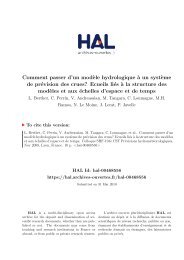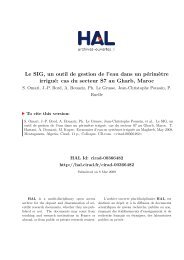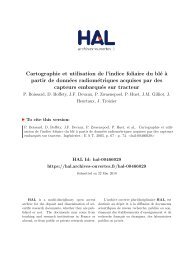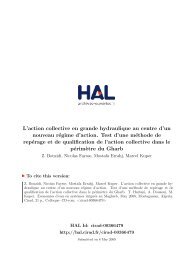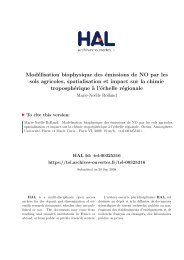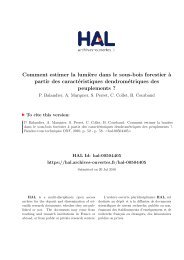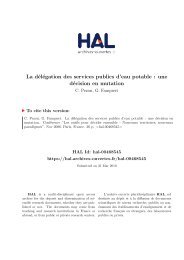[lirmm-00293132, v1] Processing Full-Waveform Lidar Data to ...
[lirmm-00293132, v1] Processing Full-Waveform Lidar Data to ...
[lirmm-00293132, v1] Processing Full-Waveform Lidar Data to ...
- No tags were found...
You also want an ePaper? Increase the reach of your titles
YUMPU automatically turns print PDFs into web optimized ePapers that Google loves.
detect the number of components, we used animproved peak detection method developed in aprevious study (Chauve et al., 2007). The main stepsare:A basic detection method, based on zerocrossings of the first derivative, is used at first <strong>to</strong>estimate the number and the position of thecomponents;Using these values as initialisation values, a firstestimation of the signal is computed;An iterative process is performed <strong>to</strong> findmissing peaks by detecting echoes on thedifference between the modelled and initialsignals. If new peaks are detected, the fit isperformed again. This process is repeated until noimprovement is found.This enhanced peak detection method is useful <strong>to</strong>model complex waveforms with overlapping echoesand also <strong>to</strong> extract weak echoes which are not foundby multi-echo systems. Both cases often occur invegetated areas.3.2 GROUND POINTS CLASSIFICATIONThe classification process is based on a previouswork described in (Bretar et al.,2004). From an initiallocation within the point cloud, the filtering algorithmpropagates following the steepest localslope over a grid <strong>to</strong>pology. A neighborhood of lidarpoints is extracted at each grid location. The neighborhoodextension is set so that the overlapping ratiobetween two adjacent locations should be at least50 %. An initial estimate of the terrain elevation isperformed by calculating an average value of laserpoint height belonging <strong>to</strong> a rank filtered subset. Thefiltering algorithm is based on a bipartite voting process.<strong>Lidar</strong> points will be classified as ground or offgroundpoints depending on their height difference<strong>to</strong> the local terrain estimate (mean value of lidarpoints classified as ground points). Considering theoverlapping ratio of the neighborhoods, laser pointsare classified several times either as ground or offgroundpoints. At the end of the propagation, a labelcorresponding <strong>to</strong> the most representative votes isaffected <strong>to</strong> each lidar point.A post-processing step is performed <strong>to</strong> detectunder-terrain outliers. Such points mainly comefrom under-ground erroneous echoes that wereextracted during waveform processing. The filter isbased on a robust local plane estimation of groundpoints. Points located above a given threshold areremoved.3.3 DTM AND CHM COMPUTATIONDTMs are triangulated from lidar ground points andfinally re-sampled on a 0.5 m resolution grid, inagreement with the spatial resolution of the lidaracquisition (4-5 pts/m2).DSMs are computed from first echoes using theInverse Distance Weighting (IDW) interpolationtechnique. CHMs are obtained by subtracting DTMfrom DSM.4 RESULTS AND DISCUSSION4.1 POINT DETECTION<strong>Lidar</strong> waveform post-processing allows <strong>to</strong> improvethe density of the final point cloud up <strong>to</strong> more than130 % on very dense vegetated areas (see table 1).Table 1 shows that on large ground areas with onlysparse trees (like in plot 1), only few additionalechoes are detected. The number of detected pointsincreases when the vegetation is getting denser inboth overs<strong>to</strong>ry and unders<strong>to</strong>ry vegetation.Table 1. Statistics on the point extraction over differentplots. Plot 1: sparse Black pine stand; plot 2: dense Blackpine stand; plot 3: dense Sylvester Pine stand.Area Plot 1 Plot 2 Plot 3Nb multi-echo points 19863 1729 1566Nb fullwave points 25769 3305 3712% additional points 30 % 91 % 137 %Analyzing the differences between the fittedwaveforms and the multi-echo point cloud, one cannotice that the additional points come from weakand overlapping echoes that are now detected. Thesepoints are located near the tree canopy and in theunders<strong>to</strong>ry. Only few additional points are detectedon the ground due <strong>to</strong> the fact that pine crowns,although thin, are very dense and the laser beam canhardly get through them.Figure 2. His<strong>to</strong>grams of 3D point cloud altitudes with1 m bin size: Plot 1 (left), plot 2 (middle), plot 3 (right).Red lines correspond <strong>to</strong> multi-echo point cloud and blacklines <strong>to</strong> the additional points extracted from fullwaveformdata.
His<strong>to</strong>grams on figure 2 show the altimetricdistribution of multi-echo points (red lines) and ofadditional points detected by processing lidarwaveforms (black lines). In plot 1 (left subfigure),the landscape is hilly and as a consequence there isonly one wide peak corresponding <strong>to</strong> ground pointsand low vegetation. Due <strong>to</strong> a very low tree densitythe overs<strong>to</strong>ry peak is reduced and hardlydistinguishable. In plot 2 (middle subfigure)overs<strong>to</strong>ry and unders<strong>to</strong>ry can be clearly separated.The ground peak is also quite large because theslope of the plot is very high. Most of the additionalpoints are here located in the tree canopy. In thethird plot (right subfigure), which is relatively flat,both unders<strong>to</strong>ry and overs<strong>to</strong>ry are very dense andalmost continuous. Additional points are herelocated in the canopy as well as in the lowvegetation.4.2 DIGITAL TERRAIN MODELSTable 2 summarizes the results of thecomparison between 0.5 m resolution raster DTMsderived from multi-echo and full-waveform lidardata, and from terrain measurements. Means andRMSs were computed on the difference images.Results are homogeneous for all comparisons: lessthan 0.2 m in RMS, except for the comparisonbetween field measurements and lidar point cloud inthe first plot. In these cases (RMS = 0.57 m) errorsare mainly due <strong>to</strong> an insufficient field measurementsample for describing the hilly <strong>to</strong>pography of thefirst plot.Table 2. Statistics on DTM (in m).AreaMean(m)RMS(m)Plot 1: difference multi-echo – fullwave -0,02 0,15Plot 1: difference field – multi-echo 0,08 0,57Plot 1: difference field – fullwave 0,05 0,57Plot 2: difference multi-echo – fullwave 0,06 0,20Plot 2: difference field – multi-echo -0,04 0,16Plot 2: difference field – fullwave 0,01 0,204.3 CANOPY HEIGHT MODELSFigures 3 and 4 show results of the comparisonbetween multi-echo and fullwave CHMs for plots 1and 2. On the left the CHM is computed from multiechopoint cloud and on the right the differencebetween CHM is computed from multi-echo andfull-waveform point clouds. The range ofdifferences in height are similar in both plots: from-3 m <strong>to</strong> about 7 <strong>to</strong> 9 m. The few negative values arelocated around the trees and correspond <strong>to</strong>additional points detected in the low part of thecanopy that are not in the multi-echo point cloud.Figure 3. Plot 1: (left) CHM computed from multi-echopoint cloud; (right) difference between CHM computedfrom fullwave and from multi-echo point clouds.Figure 4. Plot 2: (left) CHM computed from multi-echopoint cloud; (right) difference between CHM computedfrom fullwave and from multi-echo point clouds.<strong>Waveform</strong> processing did not improve the DTMon these two plots, because very few additionalpoints were detected on the ground (around 6 %) forthe first plot and because the classification betweenground and low vegetation is still an issue in denseand near-ground vegetation (0.3 <strong>to</strong> 1 m) for thesecond plot.Figure 5. His<strong>to</strong>grams of CHM differences between.Plot 1 (left, 0.22 m mean difference; Plot 2 (right, 1.7 mmean difference).His<strong>to</strong>grams of CHM differences are plotted onfigure 5. These his<strong>to</strong>grams are linked <strong>to</strong> thevegetation density and cannot be directly compared.Nevertheless, what is noticeable is that on a denseforest area processing waveforms significantlychanges the description of the canopy: volume,
height and 3D structure are expected <strong>to</strong> beimproved. Detailed validation of the canopy shapewith field measurements is in progress.5 CONCLUSIONS AND FUTUREWORK<strong>Processing</strong> lidar waveforms has been investigated inthis paper in order <strong>to</strong> extract more echoes thanequivalent multi-echo data. We studied thealtimetric distribution of additional points andevaluated the potential of processing waveforms <strong>to</strong>improve DTM and CHM. DTMs were finallycompared <strong>to</strong> field measurements.Improving peak detection was shown in thispaper <strong>to</strong> be very successful <strong>to</strong> extract additionaltargets in the return waveforms. Depending onvegetation density, we detected from 30 % <strong>to</strong> 130 %additional points. These points are located mainlywithin the canopy and in highly dense unders<strong>to</strong>ry.Very few additional points were detected on theground, which explains why the DTMs were notsignificantly improved. On the contrary, CHMreally benefited from waveform processing as thenumber of echoes were doubled in the overs<strong>to</strong>ry andinside the canopy. The 3D structure of thevegetation is thus expected <strong>to</strong> be significantlyimproved, and detailed field measurements are inprogress <strong>to</strong> confirm this result.Modeling raw lidar signal also enables <strong>to</strong> extract,beyond target position, additional parameters whichare of interest <strong>to</strong> study the geometry and theradiometry of the targets: both echo intensity andwidth, and also shape parameters when complexmodels, such as generalized Gaussian model, areused <strong>to</strong> decompose lidar waveforms in<strong>to</strong> a sum oftarget contributions. This information is promising<strong>to</strong> improve the classification of ground and lowvegetation points, and also <strong>to</strong> identify tree species.ACKNOWLEDGMENTSWe thank Laurent Albrech for his help during thefield data measurement campaigns and NicolasDavid for his help <strong>to</strong> georeference the lidar data. Wealso thank the GIS Draix and the Cemagref ofGrenoble for providing the full-waveform lidar data.Field measurements were realized thanks <strong>to</strong> thefinancial support of CNES.REFERENCESBrandtberg, T., Warner, T.A., Landenberger, R.E. andMcGraw, J.B., 2003. Detection and analysis ofindividual leaf-off tree crowns in small footprint, highsampling density lidar data from the easterndeciduous forest in North America. Rem. Sens.Environ., 85(3): 290-303.Persson, A., Holmgren, J. and Soderman, U., 2002.Detecting and measuring individual trees using anairborne laser scanner. Pho<strong>to</strong>gram. Eng. Rem.Sensing, 68(9): 925-932.Nilsson M., Brandtberg T., Hagner O., Holmgren J.,Persson A., Steinvall O., Stemer H., Söderman U. andH., O., 2003. Laser scanning of forest resources. Theswedish experience. ScandLaser Scientific Workshopon Airborne Laser scanning of Forests, pp. 43-51.Hyyppä, J., Hyyppä, H., Litkey, P., Yu, X., Haggrén, H.,Rönnholm, P., Pyysalo, U., Juho Pitkänen, J. andMaltamo, M., 2004. Algorithms and Methods ofAirborne Laser-Scanning for Forest Measurements. InInternational conference "Laser-scanners for Forestand Landscape Assessment", XXXVI, part 8/W2: pp.82-89.Lefsky, M.A., Cohen, W.B., Acker, S.A., Parker, G.G.,Spies, T.A. and Harding, D., 1999. <strong>Lidar</strong> remotesensing of the canopy structure and biophysicalproperties of Douglas-fir western hemlock forests.Rem. Sens. Environ., 70(3): pp. 339-361.Naesset, E. and Bjerknes, K.-O., 2001. Estimating treeheights and number of stems in young forest standsusing airborne laser scanner data. Rem. Sens.Environ., 78(3): pp. 328-340.R. Dubayah, J. Blair, <strong>Lidar</strong> Remote Sensing for ForestryApplications, Journal of Forestry 98 (6) (2000) 44–46.Chauve, A., Mallet, C., Bretar, F., Durrieu, S., PierrotDeseilligny, M. and Puech, W., 2007. <strong>Processing</strong> fullwaveformLiDAR data : modelling raw signals. InLaser Scanner et Sylvilaser 2007, 12-14 sept. 2007.Wagner, W., Ullrich, A., Ducic, V., Melzer, T. andStudnicka, N., 2006. Gaussian decomposition andcalibration of a novel smallfootprint full-waveformdigitising airborne laser scanner. ISPRS Journal ofPho<strong>to</strong>grammetry and Remote Sensing 66, 100–112.Hof<strong>to</strong>n, M., Minster, J. and Blair, J., 2000.Decomposition of Laser Altimeter <strong>Waveform</strong>s. EEETrans. Geosci. Rem. Sens. 38(4), 1989–1996.Reitberger, J., Krzystek, P. and Stilla, U., 2006. Analysisof full-waveform lidar data for tree speciesclassification. In ISPRS Pho<strong>to</strong>grammetric ComputerVision (PCV), Bonn, Germany, pp. 228–233.Persson, A., Söderman, U., Töpel, J. and Alhberg, S.,2005. Visualization and Analysis of <strong>Full</strong>-<strong>Waveform</strong>Airborne Laser Scanner <strong>Data</strong>. In ISPRS workshop’Laserscanning 2005’, Enschede, The Netherlands,pp. 103–108.Bretar, F., Chesnier, M., Pierrot-Deseilligny, M. andRoux, M., 2004. Terrain modeling and airborne laserdata classification using multiple pass filtering. InProc. of the XXth ISPRS Congress, IAPRS, Vol.XXXV part B, ISPRS, Istanbul, Turkey, pp. 314–319.


![[lirmm-00293132, v1] Processing Full-Waveform Lidar Data to ...](https://img.yumpu.com/48518247/1/500x640/lirmm-00293132-v1-processing-full-waveform-lidar-data-to-.jpg)
